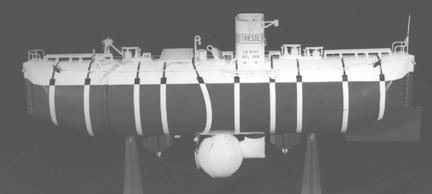
TRIESTE I
Type: Deep Submergence Vessel
HNSA
|
|
|
RETURN TO PAGE-1 || Proposed Veteran Memorials |
|
|

| Length: 59.5 feet
Beam: 11.5 feet Draft: 18 feet (loaded) Displacement: 50 tons without gasoline; 150 tons with gasoline. Operating Crew: One crew members and one scientist. Buoyancy Control: Water buoyancy control; compressed air for positive buoyancy, sea water for negative buoyancy. Gasoline could be pumped out to speed descent. Built by Swiss professor, scientist, inventor and explorer Auguste Piccard. His son Jacques later worked with him on over 100 test dives, 26 of which were financed by the U.S. Navy. Trieste I and II are also considered to be bathyscaphes -- a Greek term meaning deep ships. They are able to sink into the depths of the ocean, and then rise to the surface utilizing the same scientific principles a blimp uses to rise and then return to its starting point A first hand account by the OIC TRIESTE
|
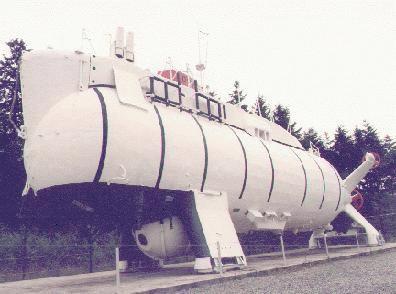
Type: Deep Submergence Vessel
HNSA
| Length: 78 feet, Beam: 15 feet; 18+
feet at propeller pods
Design Depth: 20,000 feet Displacement: 85 tons on the surface (empty); 336 tons submerged Operating Crew: Two crew members and one scientist Submerged Endurance: 12 hours at 2 knots Buoyancy Control: Uses fuel-buoyancy control; aviation gasoline for positive buoyancy and iron shot for negative buoyancy CLICK for larger view of TRIESTE II. [ Image contributed by Frank Toon ] |
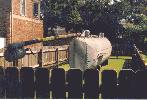
| (June 2001) To go along with the latest news of the raising of the CSS HUNLEY here is more about the HUNLEY and other Confederate submersibles. Excerpted and adapted from the website of Bob Hunt, a former USN Corpsman who now resides in Charleston, SC |
to replicas of two important
vessels of the Civil War.
by Bob Hunt
| At the Berkeley Historical Society
and Museum in Moncks Corner, there is the replica of a "David" which is
a submersible vessel developed here in the lowcountry under the direction
of Dr. St. Julien Ravenel (1819-1882). Dr. Ravenel was a South Carolina
scientist and Confederate Surgeon of Huguenot descent.
In the Interpretive Center at Old Santee Canal Park, adjacent to the Berkeley Museum, there is a 3/8 scale of a "David" with interior details. At the Charleston Museum, there is the replica of the Confederate submarine Horace L. Hunley. In the State Museum in Columbia, SC you may view another replica of the Hunley, complete with cutaway showing mechanism and crew members at work inside. And, in the Lasch Conservation Center in North Charleston (at the old Navy Base near Charleston) is the real submarine, the CS Hunley - discovered in the ocean waters off Sullivans Island, SC by Clive Cusler.
CS David was the name of the first torpedo boat of the design identified as a "David". Not much has been written about the "Davids", which is remarkable when their importance in history is so significant. When U.S. Adm. John A. Dahlgren entered Charleston Harbor in February, 1865 he reported that there were nine "Davids" in the harbor and two in the mud of the Cooper River. No names are given for the other "Davids"; indeed, they may have been unnamed. The name "David" apparently is derived from Goliath's opponent, refering to the size of the boat. There is some discussion that it may be named for its contracting engineer, David Chenowith Ebaugh (pronounced EE-BOE), originally of Maryland. No documents of that period attest to the number or names, except for the first, David. Ebaugh wrote about his participation and claimed credit after the War.
The CS David executed the first successful torpedo attack in naval warfare, on October 5, 1863, against the USS New Ironsides, outside Charleston Harbor. The David returned to Charleston harbor; the New Ironsides was damaged but survived the attack. The first "David" was developed by the Confederates as a submersible, moving just under the surface of the water with its smokestack extending above. Because of its actions (and those of other similar ships), the Union Navy was forced to develop measures to defend their ships against this type of craft. As a result, only vessels further out to sea were without such defensive measures because it was felt that the submersibles could not go very far to sea. This is why the Hunley was forced to go further to sea to attack the USS Housatonic, after which the Hunley disappeared. Horace Hunley and his crew (who died on an earlier trial) are buried in Magnolia Cemetery at Charleston. The Hunley itself was raised from the depths in 2000 following location by Clive Cussler, and is in restoration at the Warren Lasch Center at the old Navy Base in North Charleston, SC. The State of South Carolina is working with other sources to continue the development of resources to provide for the restoration and display of the vessel as well as for the recovery and interment of the remains of the Confederate troops who manned the sub. The estimated total cost of the Hunley project approaches $20,000,000. The local newspaper, The Post and Courier, has quite an archived section on their Hunley coverage, with links to similar sites. (Images provided by Bob Hunt) Sources:
The HUNLEY NEWS ARCHIVES from the Charleston Post and Courier The Official HUNLEY website The Charleston Museum The H.L. Hunley in Historical Context (A USN Official History website) by Rich Wills, former Assistant Underwater Archaeologist, Naval Historical Center |
Home
of the USS Growler
See the evolution of modern submarine
hulls and learn of the first
successful rescue of the crew from
a sunken sub.
![]()
The
Navy Museum Washington Navy Yard
901 M Street, Southeast
Washington, DC 30374-0571
(202) 433-4882
Fax: (202) 433-8200
![]()
Museum
2
Market St.
Paterson,
NJ
| Acclaimed by the United States Navy
as the "Father of the Modern Submarine, " Paterson schoolteacher, John
Philip Holland, triumphed over disappointments and failure to achieve the
pratical use of the submarine. Beginning with his one man submarine, Holland
#I, Holland developed his principles of underwater navigation until the
U.S. Navy accepted the Holland #VI, in 1900, as the first vessel in the
American Submarine Fleet.
On permanent display are the hulls of Holland-1, 1878 and Holland-2, 1881. The Holland-1 is fourteen feet, six inches in length, and weighs two and a quarter tons. It traveled at three and a half miles per hour, and could remain under water for one hour. For an excellent page on the Holland and the Fenian Ram |
Edward
M. Graf
Patterson, NJ Museum.
| A very complete collection of notes, letters, drawings, diagrams, and specifications of the premier inventor of the modern submarine, John Philip Holland. |
See Bushnell's Turtle
| The Connecticut River Museum represents
various phases of Essex's seafaring past, and a number of its artifacts
are bound to intrigue visitors of any age.
One favorite is the Turtle, designed by David Bushnell as a one-man submarine; it resembles the shells of two turtles clamped together. Both George Washington and Benjamin Franklin encouraged Bushnell to build it in l776, but it was no match for the HMS Eagle as it tried to attack and destroy her. An interesting theory, nonetheless, that was ahead of its time. 67 Main Street,
The museum is located at the foot of Main Street. Open Tuesday through Sunday from 10:00 A.M. to 5:00 P.M. Admission is $4.00 for adults, $3.00 for seniors, and $2.00 for children 6-12. Kids 5 and under free. There is a gift shop on the premises. The museum is accessible to the disabled. Guided tours are available by special arrangement only |
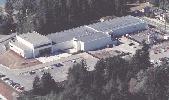
Naval
Undersea Museum
Naval
Undersea Museum || Official
USN Keyport Website via (NUWC)
PO Box 408,
Keyport, WA. 98345,
(360) 697-1129
| Getting
There From Seattle, visitors can take the Bremerton,
Bainbridge Island, or Kingston Ferries. In Kitsap County, take highway
3 to route 308, follow the signs to Keyport.
Hours: Summer: Daily: 10AM till 4PM, Winter (October through May): Wednesday - Monday: 10AM till 4PM Closed Tuesdays......Admission is free. |
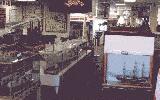
130 Washington Ave Bremerton 360-479-SHIP
Features: maritime exhibits, ship models,
mockup of
ship's bridge, history of Puget Sound
Naval Shipyard
Tues-Sat 10am-5pm Sun 1-5pm donation
![]()
Portsmouth
Naval Shipyard Museum
High and Water Street
Portsmouth, Va.
Contains memorabilia of the armed forces
and local area,
including ships models, flags, maps
and uniforms.
![]()

Click
for Full Image
Image opens in a new window
Fredericksburg, Texas
| Book store sells the Limited Edition
print "Up-Periscope - Submarine operations in the Pacific 1941-45". A Limited
Edition of 150, issued in 1989. Signed by Medal of Honor recipients: Eugene
Fluckey, U.S. Submarine Skipper; George Street, U.S. Submarine Skipper;
Richard O'Kane, U.S. Submarine Skipper;Chester W. Nimitz, Jr., Submarine
Skipper, World War II, Silver Star decorated son of Admiral Chester Nimitz.
Admiral Chester Nimitz, who was Commander-in-Chief Pacific during World War II, grew up in Fredericksburg, and this museum is housed in the restored Nimitz Hotel once owned by his grandfather. The elder Nimitz had been a member of the German merchant marine before he came to Texas in 1848 and started his successful hotel business. His hotel was the most comfortable stop on the military road between San Antonio and San Diego. It had the frontier's first bathhouse, as well as a brewery, saloon, general store, and a ballroom. Guests included Robert E. Lee, Ulysses S. Grant, and Rutherford B. Hayes. Today several rooms of the hotel are furnished as they were in the 19th century, but most are given over to the Museum of the Pacific War, which tells the story of Admiral Nimitz. He took charge of the Pacific fleet 18 days after the disaster at Pearl Harbor, reorganized the shattered U.S. forces, and was one of the architects of the strategy that brought victory over Japan. Behind the hotel is the Garden of Peach, a Japanese-style garden created with money raised by the Japanese people, whom Nimitz had treated kindly after the war. The Pacific History Walk, a block from the hotel, takes visitors through relics of the war: a Japanese dive bomber, and the conning tower of the USS PINTADO, the submarine that sank Japan's largest merchant ship. The museum has many features including the HA-19 which is the midget Japanese submarine captured at Pearl Harbor, a Memorial Wall, a Commemorative Plaque Program, A Veterans Walk of Honor and the George Bush Museum of the Pacific War. Location: The museum is located in Fredericksburg,
near San Antonio. To reach the site, take U.S. 10 about 80 miles northwest
to Fredericksburg and follow the signs to the museum.
|
A huge collection of links to California
Museums.
Not to be missed.
![]()
VALLEJO
NAVAL MUSEUM
| The Museum is called "Naval and Historical" because the City of Vallejo and the Navy have grown together since the 1850s when Mare Island became our nation's first naval base in the Western United States. Mare Island built over 500 ships for our Navy between 1859 and 1970. |
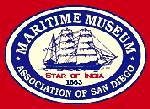
The
San Diego Maritime Museum
San Diego, CA
| The museum publishes a quarterly magazine for it's members which includes Maritime History and a history of the Pacific War. Located at the foot of Broadway on the bay. |
USS BONEFISH Monument to three men lost,
Sasebo, Japan
![]()
The
UNITED STATES SUBMARINER MEMORIAL BUILDINGS & STRUCTURES PROJECT
![]()
The
Fin Project:
From
Swords into Plowshares
Mission of the Fin Project: text below
from John Young, the Fin Project artist.
| It expresses the hope of world peace
by recycling decommissioned nuclear submarine parts into art. At the same
time, it is meant to honor the men that served our country in the US Submarine
Force by preserving the fairwater planes from these great ships that helped
keep the world at peace during the Cold War and at other times in our history.
There are currently two installations: one in Magnuson Park in Seattle; and now this recently completed one in Pelican Harbor Park in Miami on the 79th St Causeway between Miami and Miami Beach. Both sites employ 22 fairwater planes from 1960s fast attack and ballistic subs. These 44 fins are the very last remnants of these historic boats. The works were funded totally by private and corporate donations to our non-profit 501(c )3 corporation. The US Navy donated the fins from PSNS in Bremerton, WA. For images of the Seattle version you can view the website: http://faculty.washington.edu/jtyoung John Young - Artist |

Seattle,
Washington
Dedicated on Memorial Day 1998.
Warren Magnuson Park on
Lake Washington
Also see Ric
Hedman's page on the FIN PARK
A City of Seattle link
about the FIN Project
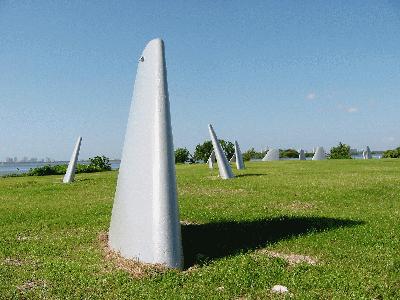
Miami,
Florida
Pelican Harbor Park
The Miami sculpture was installed in
2002
and dedicated on Veterans Day, 11 November
2003
Full story on Memorials
by State: Florida Scroll down
![]()
| SUBMARINE LORE
By John Chaffey, Powell, Wyoming SSN-639, SSN-687, SSBN-619 This is a tale, of Submarine Lore.
The S-Boat was courageous, she had come
a long way.
The Squalus and Sailfish, were one in
the same.
The Torsk and her crew, made a formidable
pair.
The Halibut thanked Portsmouth, for
a boat strongly built.
Tigrone saved thirty-one, so they could
fly another day.
Names like Gilmore, Cromwell, Dealey
and Street.
There were other fearless boats, like
the Ray and the Rasher.
In almost 4 years of war, 52 boats met
their fate.
|